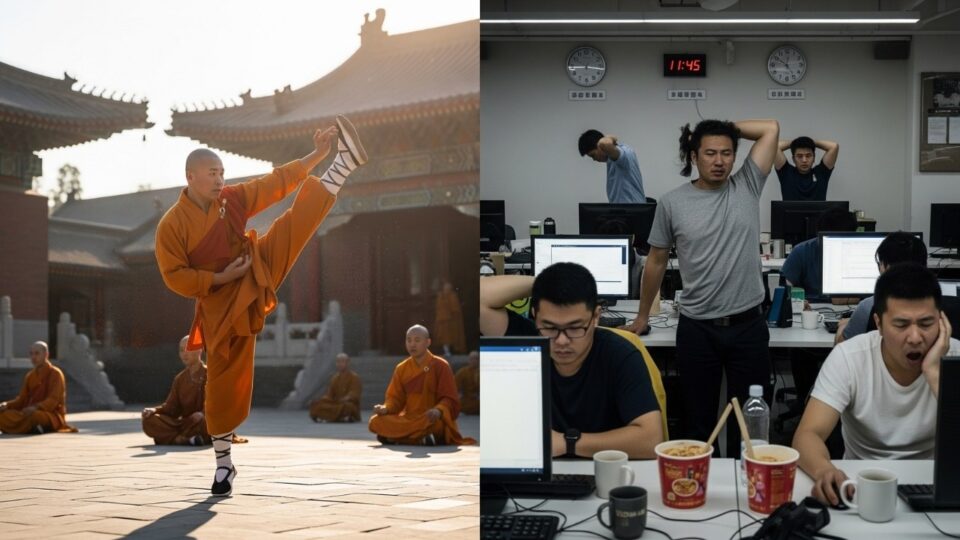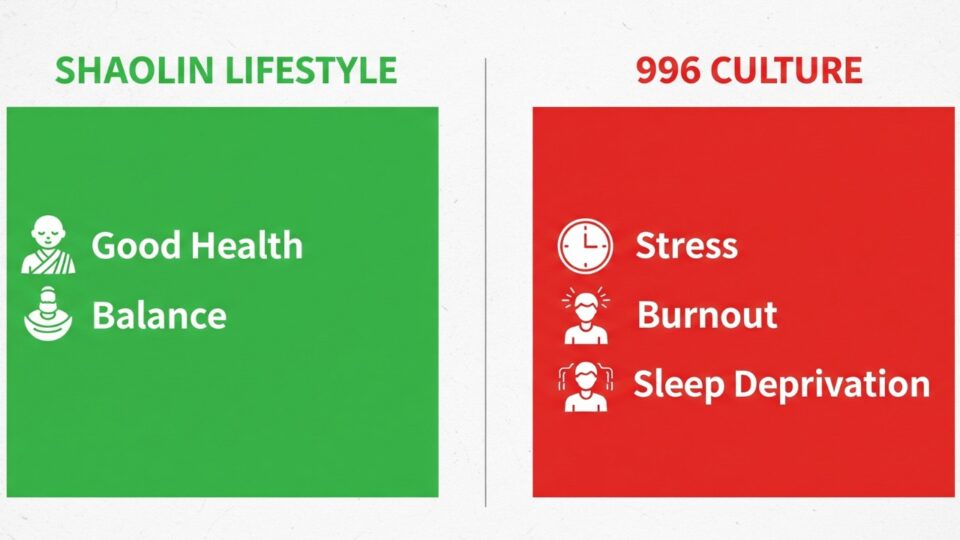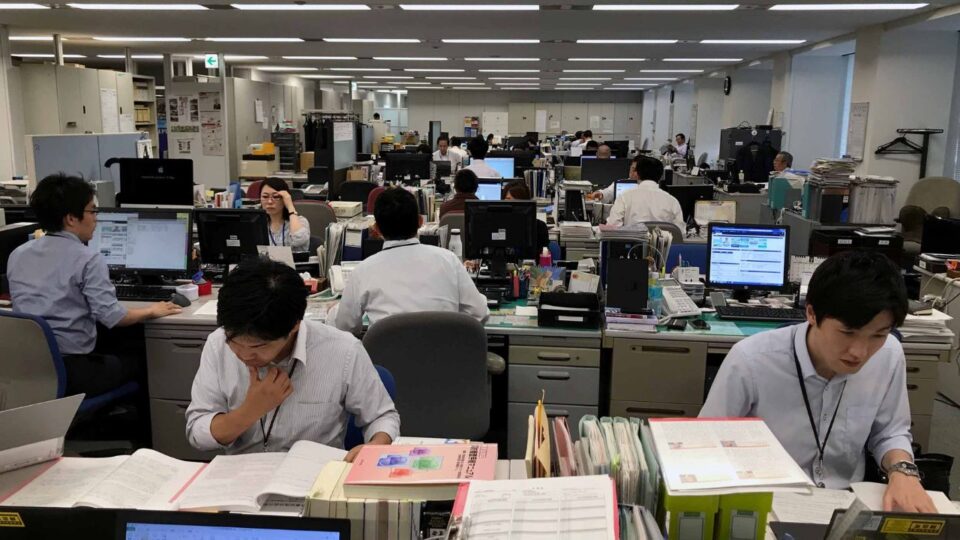At dawn, a gong echoes across the misty slopes of Mount Song. Shaolin monks rise, not to check emails or answer urgent notifications, but to meditate, stretch, and breathe in rhythm with the morning air. Thousands of kilometers away in Shanghai, a programmer jolts awake at 8:30 a.m., downs a quick coffee, and rushes into another twelve-hour marathon dictated by the infamous 996 work culture — nine in the morning to nine at night, six days a week.
Both lives demand discipline. Both push human endurance to its limits. Yet one nurtures the body and spirit, while the other often leaves both depleted.

What is the 996 Work Culture?
The term “996” has become shorthand for one of the most controversial aspects of China’s modern economy. It refers to a relentless schedule: working from nine in the morning until nine at night, six days a week. Originally popularized in the booming tech sector, the 996 culture was once celebrated as a symbol of ambition and innovation. Some executives even branded it as a “blessing,” suggesting that long hours were essential to success.
But behind this narrative lies a darker reality. Workers pushed into the 996 lifestyle frequently report exhaustion, declining health, and strained relationships. The physical toll is undeniable. Fatigue builds up, sleep becomes a luxury, and chronic health issues often follow. The mental strain is equally heavy. Stress and anxiety become permanent companions, and many young employees burn out before they ever reach their prime. Even China’s Supreme People’s Court declared that 996 violates labor laws — yet the practice persists, driven by competition and the fear of falling behind.

Life at the Shaolin Temple
The Shaolin Temple, perched on Mount Song in Henan Province, follows a rhythm that seems like a different world. The day begins early, but not for corporate deadlines. Instead, monks wake to meditate and chant, centering their minds before physical training begins. The mornings are filled with rigorous martial arts practice, hours of movements repeated with precision, sometimes under the blazing sun or in the freezing cold of winter.
Their afternoons may involve simple communal tasks like cooking, cleaning, or maintaining the temple grounds. Meals are plain, vegetarian, and carefully balanced to nourish the body without excess. In the evening, meditation returns, allowing the monks to settle their minds after a day of physical exertion. This routine is strict, but it is not meant to exploit. Rather, it is a system designed to cultivate endurance, resilience, and spiritual clarity.
Similarities on the Surface
At first glance, one might see parallels between the Shaolin routine and the 996 schedule. Both require unwavering discipline. Both demand that individuals push past their comfort zones, whether through intense physical drills or grueling office deadlines. Both also involve submitting to a larger system of rules, whether it is the code of the temple or the hierarchy of a corporation.
But the similarities end there. The heart of these two systems beats to very different rhythms, and the ultimate outcomes diverge in ways that could not be more profound.
The Core Difference: Purpose
The fundamental difference between Shaolin discipline and the 996 work culture lies in purpose. Shaolin training is not about producing more output or chasing financial profit. It is about aligning the mind and body, seeking inner balance, and nurturing both strength and compassion. Every punch, every breath, every meditation is a step toward self-mastery.
The 996 system, by contrast, has no such higher calling. It exists to squeeze as much productivity as possible out of workers for the sake of corporate growth. The hours are not an investment in the individual’s well-being or long-term development, but rather in quarterly reports and market competition. The result is often exploitation rather than transformation.
Health and Longevity: Shaolin Wins
Medical research on overwork paints a sobering picture. Long working hours are directly linked to cardiovascular disease, higher risks of stroke, and increased rates of depression. In Japan, the term karoshi — literally “death by overwork” — is a grim reminder of what can happen when human beings are pushed beyond their limits. China’s 996 workers live under the shadow of the same risks.
The Shaolin lifestyle, despite its intensity, produces the opposite effect. Monks often maintain strong physical health into old age. Their diet is clean and plant-based, sleep is treated as an essential part of the routine, and physical training is balanced by mindfulness and meditation. Instead of draining vitality, Shaolin discipline replenishes it. This contrast highlights an essential truth: it is not the number of hours one spends in effort that determines well-being, but the harmony and intention within those hours.

Mindfulness vs Mindlessness
Another striking difference lies in the mental state each system produces. Life under 996 leaves little room for reflection. Workers rush from task to task, reacting to deadlines, emails, and meetings in an endless cycle of stress. Over time, the nervous system remains in fight-or-flight mode, fueling anxiety and emotional exhaustion.
At Shaolin, the opposite takes place. Every movement is performed with awareness. Breathing is synchronized with action, and meditation intersperses moments of rest and effort. Neuroscience has confirmed the benefits of such mindfulness practices: reduced cortisol levels, improved focus, and greater emotional stability. Shaolin monks learn to harness their energy with intention, while 996 employees often find themselves drained by mindless repetition.

Lessons Modern Workers Can Learn from Shaolin
What can a modern professional, caught in the grind of deadlines and overtime, take from a centuries-old temple? The answer lies in adopting principles rather than copying routines. Shaolin monks treat rest as sacred, not as wasted time. Their physical training is not about burning calories, but about cultivating strength and resilience that supports the rest of their lives. And perhaps most importantly, every action, from eating a meal to throwing a punch, carries mindfulness and purpose.
Modern workers can borrow from this approach by setting boundaries for rest, incorporating mindful practices into daily routines, and ensuring that their labor aligns with personal values rather than being consumed entirely by corporate demands.
Global Context: 996 Is Not Alone
The struggle with overwork is not unique to China. Japan’s phenomenon of karoshi reflects the deadly consequences of similar patterns. In Silicon Valley, the myth of the “always-on” entrepreneur encourages burnout disguised as passion. Around the globe, cultures of overwork continue to dominate, often at the expense of mental health and family life.
Yet there are models that challenge this trend. In France, laws protect the “right to disconnect” after working hours. Northern European countries such as Denmark and the Netherlands consistently rank high in work-life balance while still maintaining strong economies. These societies demonstrate that prosperity does not require relentless overwork. In this sense, Shaolin philosophy — rooted in balance, discipline, and harmony — is closer to the future of healthy work than the 996 system.

Conclusion – The Harder Life Is Not Always the Better Life
The 996 work culture measures success in output and profit margins, often at the expense of human well-being. The Shaolin Temple, on the other hand, measures success in inner peace, health, and mastery of the self. One burns out the body and spirit, while the other refines them.
As debates about the future of work continue, perhaps the lesson lies not in working harder or longer, but in working with balance, purpose, and presence — the way of Shaolin.
So, if given the choice, would you wear the monk’s robe or the corporate badge?